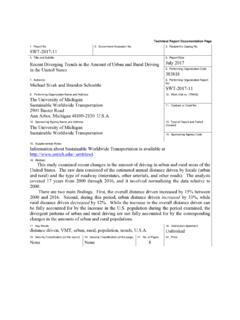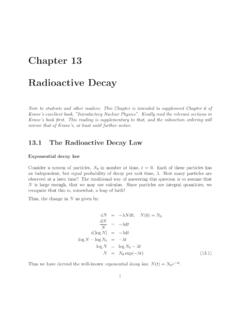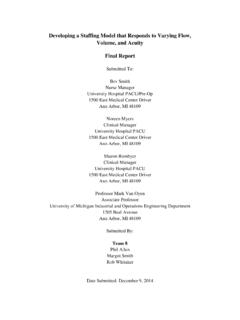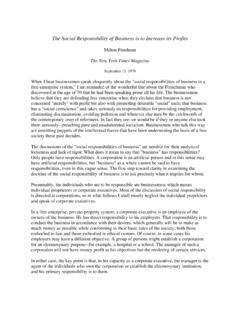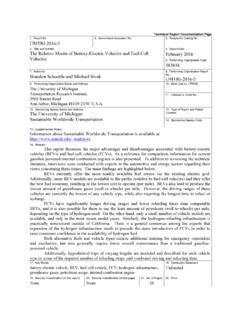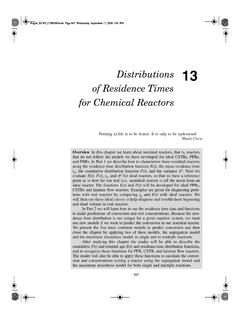Transcription of Environmental Finance - University of Michigan
1 Environmental Finance 1 - Compendium Introduction " Environmental Finance : Value and Risk in an Age of Ecology" Naronal Pol~ri;r Preventm Center tor Higher Educatorl Un~versity 01 M~chigan I May be reprodilced Daqa Bullding 43C Easl Un~versily Anq Arbor MI 15 ' freely !or non-commercial I 734 704 ,412 Fax - nppc@urnrch edu - ~ ~ I ebuca:ional p~~:poses. I The National Pollution Prevention Center for Higher Education ~nlverslt~ of Mlchlgan Dana Bu~ldlng 430 East Un~vers~ty Ave Ann Arbor, MI 48103-1 115 Phone 734-764-1 41 2 Fax 734-647-5841 E-mall. nppcQumlch edu The mlssion of the NPPC #.s lo promote sustalnable development by educat~ng. stu3ents. faculty. and professionals about pollut~on prevention: create educational materials: provide tools and strategies for addressing relevant Environmental problems; and establish a national network of pollution prevention educators. In add~tion to developing educational materlals and conduct~ng research, the NPPC also offers an Internship program, profes- s~onal education and tralnlng, and conferences 2 lntroduct~on Mav 1998 Your Input is Welcome!
2 We are very Interested rn your feedback on these materiais. Please take a moment to offer your comments and communicate them to us. Also contact us if you wlsh to recelve a documents I~st. order any of our materials. collaborate on or review NPPC resources, or be lrsled In our D~rectory of Pollution Prevent~on ~n Higher Educat~on. We're Online! The NPPC provides information on ~ts programs and educatlonal materials through the Internet's Worldwide Web; our URL IS- Please contact us 11 you have comments about our online resources or suggestions for publ~c~zlng our educatlonal materlals through the Internet. Thank you1 Business Strategy and thc Enmrammt, Vol. 5,198-206 (19%) Environmental Finance : VALUE AND RISK IN AN AGE OF ECOLOGY Mark A. Wte, Mchtire School of Commerce, University of Virginia, Charlottesde, Vir@a, USA Environmental issues are restructuring markets and reduecting capital flows throughout the world.
3 An outline is pro- vided of concerns facing the development of an environmentally responsible or ' Environmental Finance ' perspective. It reviews the major ways in which organ- izations are respondmg to Environmental threats and opportunities in the three major branches of Finance - corporate Finance , investments and financial institutions - hghlighting in particular novel programs and initiatives. In the past, financial concerns have exacerbated the degradation of the natural environ- ment; in the future, they probably hold the key to their preservation. Only after the last tree has been cut down, only after the last river has been poisoned, only after the last fish has been caught, only then will you discover that money cannot be eaten. (Cree Indian Prophecy) CCC W733/%/03019&09 1996 by John Wiley & Sons, Ltd and ERP Environment. R ecent years have seen an explosion of concern by individuals, businesses and governments regarding the use of the natural environment.
4 The 'greening' of business is underway as Environmental issues impact and change managerial practices throughout the world. Global integration of the world's financial markets is progressing at a breathless pace and, in some instances, has fostered and/or accelerated the degradation of natural environments. In others, the free flow of capital has faditated a redirection of financial resources towards investment opportun- ities, promising overall increases in both human and Environmental welfare. This paper seeks to achieve two objectives. Firstly, it attempts to define the structure of the financial system with respect to the natural envir- onment. Secondly, it outlines ways in which Environmental concerns are impacting financial deasion-malung by corporations, investors and financial institutions, briefly describing the current responses to these challenges. The financial system faditates the exchange of financial resources among economic agents.
5 The exchange of resources is generally not an end in itself; rather, decision- makers engage in such activity to further their own designs. Understanding the relationship between Finance and the environment requires an examina- tion of the goals of human activity and the role of hanaal markets in achieving those goals. THE FIELD OF Finance Traditionally, the role of the hanaal system has been to fadlitate the transformation of savings into investment. Financial institutions (banks, brokerage BUSINESS STRATEGY AND THE ENVIRONMENT houses, insurance companies) accomplish this by creating financial instruments (deposits, mutual funds, insurance policies) which are traded on finanaal markets. By thts means savings, income remaining after current-period consumption, are redirected into various forms of productive capital. The field of Finance is often divided into three branches: (i) managerial or corporate Finance , prirnar- ily concerned with the investment and finandng derisions of corporations and other business organi- zations; (ii) investments, whch seek to achieve the greatest return for a gven level of risk and (iii) finanaal institutions and markets, dealing with issues specific to the management of finanaal institutions and/or the operation of finanaal markets.
6 As a Uphe, hance works towards maximking value wlule managing risk Because risk and value are two sides of the same coin (decreasing risk inueases value and vice versa), it is impossible to entreat one without invohg the other. Uncertainty in estimating both risk and value, particularly with regard to Environmental amenities, is the source of much fnction between economists and environmentalists. Finance is often dehned as a form of applied economics relying heavily on ~nformation collected in accounting. It comes as no surprise, then, that many of the tools and analyses used in Finance are rooted in these fields. The majority of environ- mental amenities are not traded in markets, either because property rights are not well defined (fish- eries, biodiversity) or because the services in question are public goods (clean air and water, beautiful views, etc.). The disapline of economics offers numerous methods for dealing with both problems and also provides teduuques for valuing non-marketed Environmental assets, a first step in financial decision-rnakmg.
7 New accounting techniques are expandmg the measurement of Environmental costs and benefits to indude regulatory costs, auditing costs, volun- tary costs, contingent costs and irnage/relationship costs. Recognition of the mynad and subtle ways Environmental issues impact companies' cost and revenue streams is often the first step in developing a proadve Environmental management program. Sirmlar efforts are taking place on the mauoeco- nomic level. Projects to ascertain the contribution of natural and human or social capital in the national income accounts have been undertaken by national governments, the United Nations, the World Bank and others (6. Ahmad et al., 1989; Peskin, 1991; IBRD, 1995). The results are informative '.. identi- fymg dozens of countries like Kenya, Libya, Nigeria and Venezuela that are, in effect, eating their seed corn countries where the accumulation of capital has been offset by the depletion of raw materials and fertile land'.
8 WHIT The hnk between Finance and the environment ulhmately rests on one's definition of capital, or endowments used in the generation of income. Classical economists recognized two forms of capital: land and labor. Recent scholars in ecological economics have identified three broad types of capital (Costanza and Daly, 1992): (i) natural capital - natural resources used to generate income, farmland, forests, and fisheries; (ii) manufactured capital - factories, buildings, tools and other artifacts; and (iii) human capital - the stock of education, skills, culture and knowledge stored in human beings themselves (see also Becker, 1975). The key in understanding the role of Finance in either exacerbating or alleviating Environmental damage is to recognize that, for the most part, the above forms of capital are substitutes for one another and that transforming one to the other generally involves a fourth kind: financial capital.
9 Financial capital, or money, enjoys a spedal place in this taxonomy, for it alone is truly fungible. It serves as a unit of account (numeraire), as a store of wealth and as the means to acquire additional welfare. Some kinds of capital, unspoiled wilderness, factories, education, etc., provide welfare in and of themselves. Financial capital is valued for its Liquihty, the ease with which it can be exchanged for the other three kinds of capital. More capital, be it natural, manufactured, human or hnancial, is preferable to less. Moreover, an inhvidual's welfare is most likely maximized by the acquisition of some combination of these four types. For example, a farmer may choose to exchange the products of his or her land and labor for a new tractor, for education, or simply for money (which is then either consumed or invested). lndvidual choices concerning the types of capital to hold and how much to consume and how much to save are ultimately responsible for the depletion or preservation of natural resources.
10 Environmental Finance Environmental Finance concerns itself with the impact of Environmental issues on financial deasion-making, which is essentially a three-step process. The first step is to identify sources of risk and/or opportunities to create value. This requires a better understanding of the interconnections between ecology and economics, which is a good thing. 'Knowledge on the whole is an environ- mentally neuhal asset that we can contribute to the future', remarks economist and Nobel laureate Robert Solow (Solow, 1991). Environmental audit- ing, ecobalance analysis and technology forecasting are useful tools in this process. The second step is to BUSINESS STRATEGY AND THE ENVIRONMENT 1 99 Environmental Finance analyze various alternatives for increasing value or laying off risk Various valuation techruques (indud- ing contingent valuation), cost-benefit analysis and full-cost accounting are used to monetize trade-offs between ddferent resource allocations.

